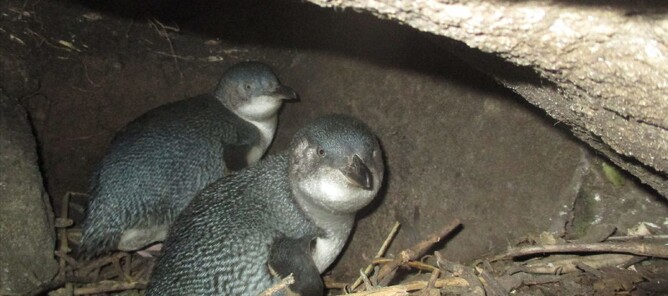Post-release survival and reproductive success of oiled little blue penguins
Research by Karin Sievwright on Little Blue Penguins at Mount Maunganui
Karin has a Bachelor of Science degree with a double major in Ecology and Zoology and has recently completed a Master’s degree in Conservation Biology. Karins Master’s research involved monitoring the post-release survival and reproductive success of oiled little blue penguins (Eudyptula minor) that were rescued and rehabilitated following the 2011 C/V Rena oil spill off the coast of Tauranga.
The purpose of her study was to assess the effectiveness of the oil-rehabilitation process used in New Zealand by determining whether rehabilitated penguins were able to survive the transition back to the wild and thereafter survive and reproduce as well as non-oiled penguins from within the local area (these are referred to as ‘control’ penguins). Before all the rehabilitated penguins were released back into the wild, they had an individually identifiable microchip/PIT-tag (passive integrated transponder) inserted in their hind neck between their flippers; at a similar time the control group was also micro-chipped.
From May 2012 three study sites, Mount Maunganui (Mauao), Leisure Island (Moturiki) and Rabbit Island (Motuotau) were monitored with the help of a fantastic group of local volunteers. These sites were chosen as the majority of the rehabilitated penguins were rescued from and returned to these sites and all of the control penguins were resident at one of these three sites.
Survival monitoring surveys were conducted fortnightly-monthly at Mount Maunganui and Leisure Island and monthly at Rabbit Island. During these surveys, all penguins encountered were caught and scanned to determine whether or not they had a microchip (from this it could be determined whether they were a control or rehabilitated penguin). Each penguin was also weighed and its behaviour in terms of its response to humans was assessed.
The breeding success of penguins at Mount Maunganui and Leisure Island was also monitored during the first two breeding seasons following the oil spill and rehabilitation operation. This involved locating nests, determining the identity of the breeding pairs (whether pairs consisted of two control penguins, two rehabilitated penguins, or a combination of both) and following the fate of each nest throughout the breeding seasons to determine factors such as clutch size, hatching success, fledging success and egg success for example. Pre-fledging chicks (those that had lost approximately 90% of their down feathers) were also weighed and micro-chipped.
From these studies it was found that rehabilitated penguins had very similar post-release survival rates to control penguins. Survival was reduced for both groups of penguins in the first six months following release from captivity (rehabilitated penguins) and micro-chipping (control penguins), however thereafter increased and remained high throughout the rest of the study. Upon release, rehabilitated penguins were heavier than control penguins, however following the first moult period, their masses had reduced to levels similar to that of control penguins and thereafter remained similar. These were positive signs indicating that rehabilitated penguins were capable of surviving following release as well as maintaining their mass throughout the annual cycle, even during stressful periods such as moult and breeding. With the exception of hatching success, all reproductive parameters measured were similar between rehabilitated pairs (those including at least one rehabilitated penguins) and control pairs (those including two control penguins). Masses of pre-fledging chicks were also similar irrespective of whether they were raised by control or rehabilitated pairs.
Karin’s research was extremely important for the management of affected wildlife during oil spills, as from these results it can be concluded that the rehabilitation process was reasonably effective at treating the negative effects of oil contamination on the survival and reproductive success of rehabilitated penguins. This therefore supports the continued conductance of oiled wildlife rehabilitation in New Zealand as well as undertaking post-release monitoring studies as they provide positive feedback on the effectiveness of the rehabilitation and thus enable the process to be adapted and improved over time to maximise success.
The Western Bay Wildlife Trust would like to thank Karin for providing us with this valuable information and for being a valued member of the penguin monitoring team.
If you would like further information on Karin’s research, you can contact us via our contacts page

